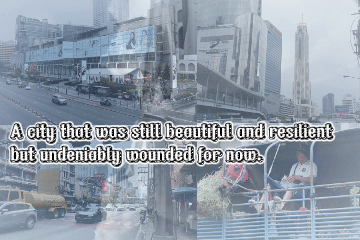
I boarded the flight to Bangkok today with surprising efficiency. From the moment boarding was announced to the final passenger stepping on, it took only fifteen minutes. That alone felt unusual.

It wasn't a small aircraft. It was an Airbus A330 with wide rows seating up to eight passengers, built to carry hundreds across borders. But as the aircraft taxied toward the runway, I looked around and was struck by the silence. The seats beside me were empty. The rows behind me were empty. Apart from a few colleagues sitting ahead, I was surrounded by nothing but vacant space.
This route would be packed on any ordinary day — families heading on vacation, businesspeople, backpackers, shoppers. And yet here I was, flying into a post-quake Thailand on a flight that felt like a ghost ship gliding through the sky.

When we landed, the emptiness followed. At immigration, there were no long lines, no crowds, no noise. The terminal felt hollow, like a shell of what it used to be.

Bangkok's streets, too, told the same story. Normally thrumming with life — tuk-tuks darting through traffic, vendors calling out in markets, tourists jostling for space — the city now felt subdued. The roads were open, the sidewalks quiet. A stillness hung in the air, not of peace, but of pause — as if the city held its breath.

I haven't seen disaster zones before. This time, I felt the absence — the missing people, the missing noise, the missing energy — left the deepest impression. A city that was still beautiful and resilient but undeniably wounded for now.
(Reported by Jack Wang; English Editor: Felicia Li)
Related News:




















Comment